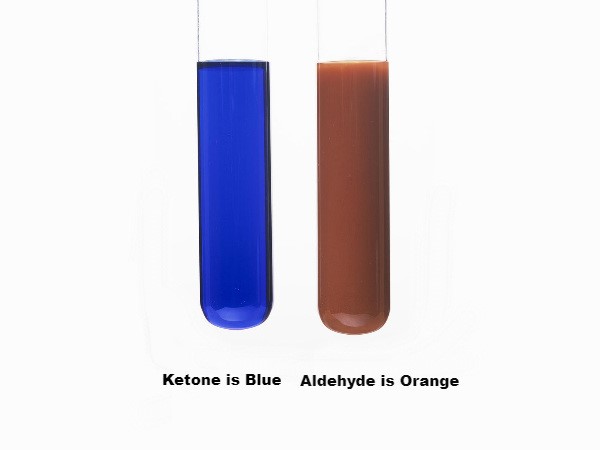Table of Contents
Fehling’s Test
- This test was first developed in 1849 by a German chemist Hermann von Fehling.
- This popular test is used to detect reducing sugars and non-reducing sugars.
- This test also can differentiate between ketone functional groups and water-soluble carbohydrates.
Fehling’s Solution
A solution mixture is used during the Fehling’s Test, which is known as Fehling’s Solution. It is usually prepared fresh in laboratories. This Fehling’s Solution is a mixture of two different solutions which are known as Fehling’s A and Fehling’s B.
Fehling’s A contains copper(II) sulphate, which is blue, while Fehling’s B is a clear liquid which contain potassium sodium tartrate (Rochelle salt) and strong alkali, usually sodium hydroxide. These two solutions are prepared individually during the test.
During test Fehling’s A and Fehling’s B solutions are mixed in equal volumes to prepare the final Fehling solution which is deep blue. The deep blue ingredient is the bis(tartrate) complex of Cu2+. The tartrate tetra-anions help as a chelating agent in the solution.

Aim of Fehling’s Test
- To detect the presence of ketone functional groups and water-soluble carbohydrates.
- To differentiate between detect reducing sugars and non-reducing sugars.
Principle of Fehling’s Test
The free carbonyl groups (aldehyde or ketone) of carbohydrates act as reducing sugars. The deep blue color Fehling solution is made up of copper sulfate mixed with potassium sodium tartrate and strong alkali, which is ordinarily sodium hydroxide.
When the heat is applied to the mixture of sample and Fehling’s solution, the bistartarocuprate (II) complex oxidizes the aldoses to corresponding aldonic acids. During this process, the copper (II) ions of the complex are reduced to insoluble yellow or red-colored precipitate or cuprous (I) oxide (Cu2O) ions.
On the other hand, the ketones are oxidized to yield shorter chains of acids. Due to the reaction of copper sulfate and sodium hydroxide, an insoluble Cu(OH)2 can be formed which is prevented by the tartrate ions by forming a bistartarocuprate (II) complex.
This complex releases cupric ions slowly for reduction, thus preventing the formation of black cupric oxide. A black precipitate of cupric oxide can be formed if the heat is applied to Fehling’s solution in the absence of reducing sugars.
Fehling’s test reaction
2Cu(OH)2 + reducing sugar → 2Cu2O + Aldonic acid
The net reaction between an aldehyde and the copper(II) ions in Fehling’s solution may be written as:
RCHO + 2 Cu2+ + 5 OH− → RCOO− + Cu2O + 3 H2O
or with the tartrate included:
RCHO + 2 Cu(C4H4O6)22− + 5 OH− → RCOO− + Cu2O + 4 C4H4O62− + 3 H2O
Requirements for Fehling’s test
- Fehling’s solution A, prepared by dissolving 7 g of CuSO4.7H2O in 100 ml of water.
- Fehlings solution B, prepared by dissolving 24 g of KOH and 34.6 g of potassium sodium tartrate in 100 ml water.
- Fehling’s solution: prepared by mixing equal volumes of both the solution just before use.
- Test Sample (5% Glucose, 5% Sucrose, 5% Fructose, 5% Starch, 5% lactose)
- Other Materials: Pipettes, Test tubes, Test tube stand, Water bath.
Fehling’s Test Procedure
- Take a clean and dry test tube and transfers 1 ml of a given sample within it. The sample concentration should be 5% (w/v).
- Take control of 1 ml of distilled water in 2nd test tube.
- After that add 2-3 drops of Fehling’s reagent within these two test tubes and mix them properly by using a vortex.
- Place the tubes within the water bath for 1-2 minutes.
- Observe the changes of color in the test tubes.
- Note down the appearance of color seen in the test tubes.
Result of Fehling’s Test
- Positive Result: Appearance of reddish-brown precipitate in test tubes, indicates the presence of reducing sugars.
- Negative Result: The absence of the reddish precipitate or the appearance of deep blue color indicates a negative result and lack of reducing sugars.

Application of Fehling’s Test
- It is used to detect the presence of aldehydes and ketones in carbohydrates as ketone sugars except alpha-hydroxy-ketone do not react in this test.
- Fehling’s test can be used to screen for glucose in the urine, thus detecting diabetes.
- Another use is in the breakdown of starch to convert it to glucose syrup and maltodextrins in order to measure the amount of reducing sugar, thus revealing the dextrose equivalent (DE) of the starch sugar.
Limitations of Fehling’s Test
- The Fehling test cannot detect Aromatic aldehydes.
- This reaction only occurs in the presence of an alkaline environment. If the mixture is acidic, the copper (II) ions would be stabilized and not easily oxidized. Then, the reaction would be failed. Alcohols and aldehydes would give the positive result also, because they can present the similar reducing group.
- Store below 30°C in tightly closed container and away from bright light.
- On opening, product should be properly stored in dry ventilated area protected from extremes of temperature and sources of ignition. Seal the container tightly after use.
Quality Control of Fehling’s Test
- Appearance: Light blue coloured solution.
- Clarity: Clear without any particles.
- Results: Standardized Fehling solution No.1 (R037) when used with Fehling solution No.2 (R038) for sugar estimation gave results in expected range of known sugar standards.
References
- https://byjus.com/chemistry/fehling-test/
- https://en.wikipedia.org/wiki/Fehling%27s_solution
- https://himedialabs.com/TD/R037.pdf
